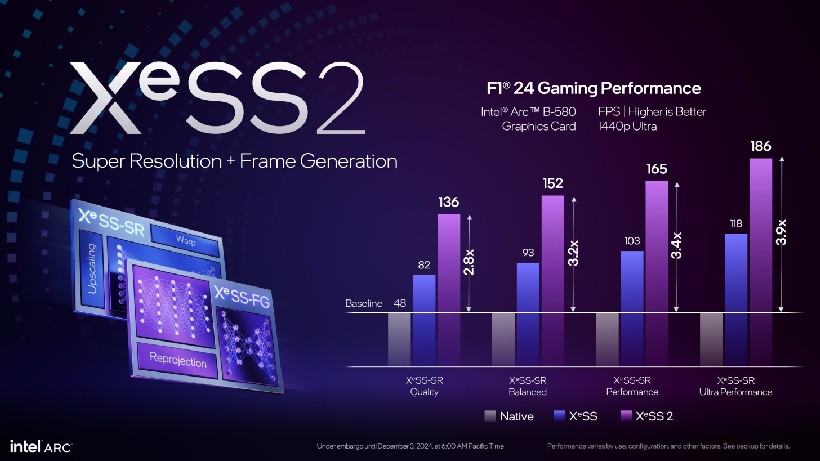Intel announces XeSS 2 image scaling technology with frame generation
09.12.24
Intel has introduced the second generation of XeSS (Xe Super Sampling) scaling technology, which is now based on a frame generation mechanism that allows you to increase performance and reduce latency. The new XeSS 2 functionality is supported on Arc Alchemist and Battlemage graphics cards and will become a direct competitor to AMD FSR 3 and Nvidia DLSS 3.
Main innovations of Intel XeSS 2:
- XeSS-FG frame generation: uses machine learning algorithms accelerated by XMX blocks in Intel GPUs. This technology allows you to significantly increase the frame rate, with a claimed performance increase of up to 3.9 times.
- XeSS Low Latency delay reduction technology: an analogue of Nvidia Reflex and AMD Anti-Lag 2. Allows you to reduce system latency, especially when frame generation is enabled, and ensures smooth gameplay at the level of the previous version of XeSS 1.3.

Support in games
The technology will be integrated into popular projects such as Assassin Creed Shadows, Dying Light 2, RoboCop: Rogue City and others.
XeSS 2 opens up new opportunities for users of Intel graphics cards, offering competitive solutions in the field of scaling and minimizing delays, which is important for modern games with high dynamics and high-quality graphics.
Don't miss interesting news
Subscribe to our channels and read announcements of high-tech news, tes
Oppo A6 Pro smartphone review: ambitious

Creating new mid-range smartphones is no easy task. Manufacturers have to balance performance, camera capabilities, displays, and the overall cost impact of each component. How the new Oppo A6 Pro balances these factors is discussed in our review.
Editor’s Choice 2025. Best devices of the year by hi-tech.ua

The best gaming laptops, mice for work, gaming keyboards, smartphones, and wireless headphones of 2025. Among them, we will highlight the most interesting ones and those that we can recommend buying.
YouTube will be completely blocked in russia YouTube
Russian authorities continue to restrict citizens’ access to independent sources of information. After blocking Instagram, Facebook, WhatsApp, Discord, Viber, and even the game Roblox
EU will not ban internal combustion engine cars after 2035 car law
European Union has revised its approach to regulating the sale of cars with internal combustion engines and abandoned the idea of a complete ban.



